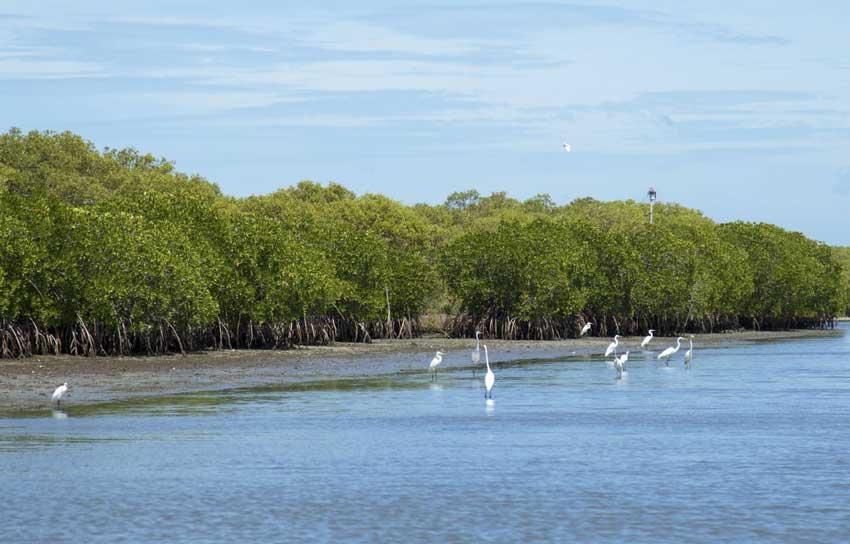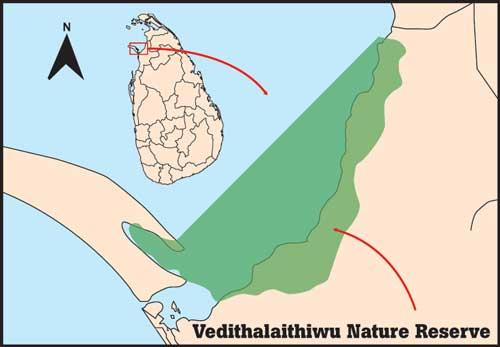Wedithalathive Nature Reserve
The report highlighted the significant biodiversity of Wedithalathive which could be lost forever
With climate change and its impacts, mangroves are important in building coastal resilience
Government of Sri Lanka adopted the Common Wealth Blue Charter in 2018
Sri Lanka submitted a resolution along with Indonesia to the United Nations Environmental Assembly, calling world leaders to take action on the global health of mangroves
Wedithalathive Nature Reserve, situated in the North western coast, adjoins the Vankalai Sanctuary in Mannar District. This is a rich and vibrant ecosystem consisting of mangroves, tidal or mud flats, salt marshes, sea grass beds as well as coral reefs, which support the livelihoods of fishermen and a hub for blue swimmer crab which brings foreign exchange to the country as a sought-after sea food.
In 2014 an Integrated Strategic Environment Assessment (ISEA) commissioned by the Northern Province in 2014 recommended to declare Wedithalathive as a Nature Reserve. This was done under Section 2 (1) of the Fauna and Flora Protection Ordinance No 22 of
2009 (FFPO), by the Gazette Extraordinary No. 1956/13 dated 1st of March 2016.
Under FFPO entrance into a nature reserve is prohibited for any purposes other than observing fauna and flora within the area.
Aquaculture project proposed by the NAQDA
In 2017, the National Aquaculture Development Authority (NAQDA) after the declaration of this area as a Nature Reserve requested the Government to de-gazette the Nature Reserve in order to carry out an aquaculture project in the area. According to the NAQDA the project’s main objective was to pave the way for foreign currency to enter the country’s economy.
The project proposes to grow fish and shellfish, including an exotic prawn species, Litopenaeus vannamei. Grow out pond-based prawn farming has largely been a failed enterprise in Sri Lanka (and elsewhere in Asia) as seen in the abandoned lands from Mundel to Puttalam, just South of Wedithalathive.
Applicable legal framework
In terms of the FFPO, altering/ceasing of an already declared Nature Reserve can only be done subject to the Section 2(4) of the FFPO. The discretion exercisable by the Minister in this regard is limited by section 2(5) of the FFPO which sets out that “In the case of any change of boundaries or the disestablishment of a National Reserve, a study shall be conducted and such study shall include an investigation of the ecological consequences of the proposed change.
Attempt to Degazette in 2017
A Cabinet Paper was prepared in 2017 to de-gazette the reserve. The paper was co-sponsored by then Minster of Fisheries and Aquatic Resources and Minister of Sustainable Development, Wildlife
Conservation and Buddhasasana. Accordingly, the ToR to conduct an Environmental Impact Study was issued by Department of Wildlife Conservation (DWC) and Central Environmental Authority.
The report highlighted the significant biodiversity of Wedithalathive which could be lost forever if the reserve was to be degazetted. In 2019, DWC appointed a Technical Expert Committee (TEC) to comment on the report, which submitted written observations against the request to de-gazette due to the obvious ecological impact resulting from the fragmentation of the ecosystem.
Despite following the due procedure outlined in FFPO and informing the Ministry of Fisheries and Aquatic Resources the decision taken by TEC, several meetings have been called even after delivering the decision to exert undue pressure to DWC and to Ministry of Wildlife by NAQDA and the Ministry of Fisheries and Aquatic Resources.
Impacts of the proposed de-gazettement of the Wedithalathive Nature Reserve
Introducing an alien species of prawn without an assessment of the effects of the species in Sri Lanka, a myriad of ecological and health impacts will follow. Such as:
- Loss of mangroves: the first lines of defense against coastal erosion;
- Loss of nurseries for fish and shellfish;
- Loss of biodiversity that comprise mangrove ecosystems and adjacent, ecologically connected littoral ecosystems;
With climate change and its impacts, mangroves (and coral reefs and dunes) are important in building coastal resilience; many countries especially island states are now restoring mangroves for coastal protection against climate change, and to sustain fisheries.
Current situation
Government of Sri Lanka adopted the Common Wealth Blue Charter in 2018 where it pledged to champion the collaboration on mangrove restoration. In March 2019, Sri Lanka submitted a resolution along with Indonesia to the United Nations Environmental Assembly, calling world leaders to take action on the global health of mangroves. In January 2020, a National Policy was formed to conserve and sustainably utilize Mangrove Ecosystems in Sri Lanka. The aim of the policy was to integrate all government agencies into the task of protecting the patches of mangroves dispersed around the island. Despite all these measures to conserve and protect mangroves in Sri Lanka, the pressure to de-gazette Wedithalathive Nature Reserve is ongoing and an attempt is currently being made by the Ministry of Environment and Wildlife Resources to de-gazette the Nature Reserve. This overall disregard for national policy of sustainable development will harm the economy in the long run.
(Environmental Foundation (Guarantee) Limited)

